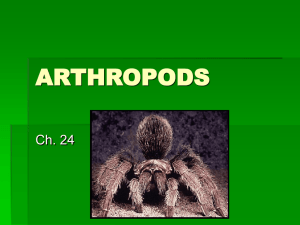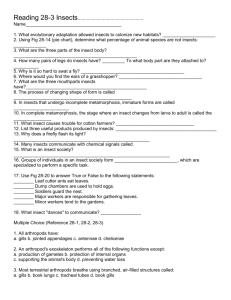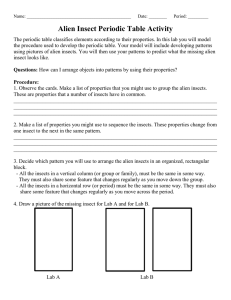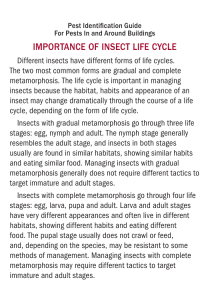Insect Anatomy & Diversity: Zoology Lab Activities
advertisement
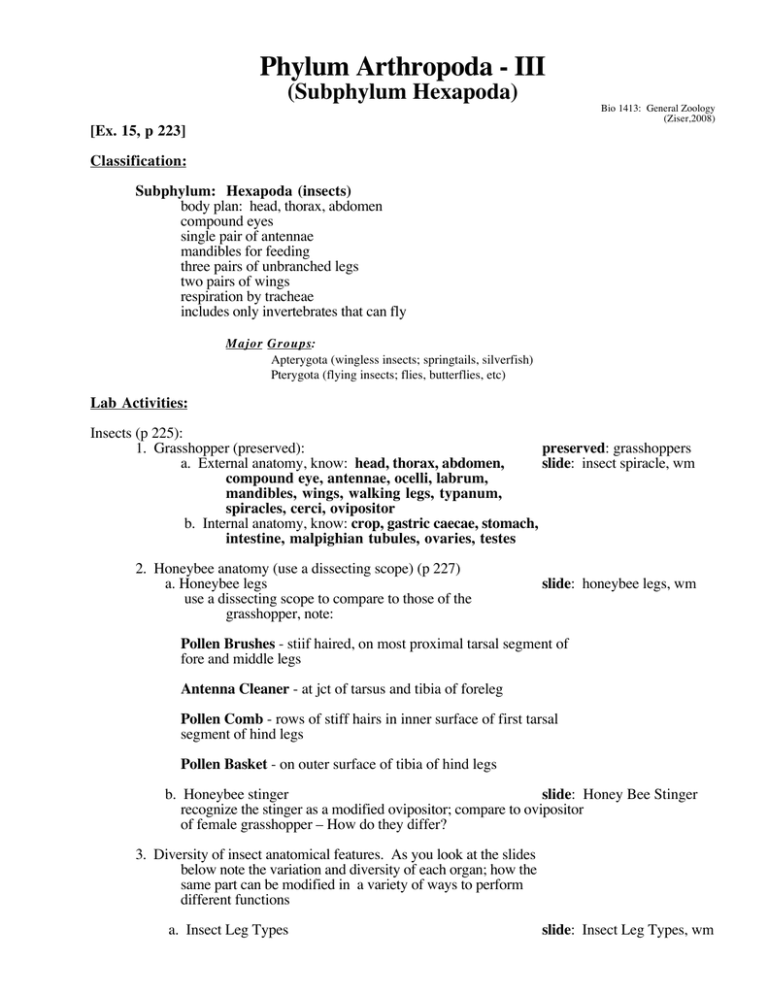
Phylum Arthropoda - III (Subphylum Hexapoda) Bio 1413: General Zoology (Ziser,2008) [Ex. 15, p 223] Classification: Subphylum: Hexapoda (insects) body plan: head, thorax, abdomen compound eyes single pair of antennae mandibles for feeding three pairs of unbranched legs two pairs of wings respiration by tracheae includes only invertebrates that can fly Major Groups: Apterygota (wingless insects; springtails, silverfish) Pterygota (flying insects; flies, butterflies, etc) Lab Activities: Insects (p 225): 1. Grasshopper (preserved): preserved: grasshoppers a. External anatomy, know: head, thorax, abdomen, slide: insect spiracle, wm compound eye, antennae, ocelli, labrum, mandibles, wings, walking legs, typanum, spiracles, cerci, ovipositor b. Internal anatomy, know: crop, gastric caecae, stomach, intestine, malpighian tubules, ovaries, testes 2. Honeybee anatomy (use a dissecting scope) (p 227) a. Honeybee legs use a dissecting scope to compare to those of the grasshopper, note: slide: honeybee legs, wm Pollen Brushes - stiif haired, on most proximal tarsal segment of fore and middle legs Antenna Cleaner - at jct of tarsus and tibia of foreleg Pollen Comb - rows of stiff hairs in inner surface of first tarsal segment of hind legs Pollen Basket - on outer surface of tibia of hind legs b. Honeybee stinger slide: Honey Bee Stinger recognize the stinger as a modified ovipositor; compare to ovipositor of female grasshopper – How do they differ? 3. Diversity of insect anatomical features. As you look at the slides below note the variation and diversity of each organ; how the same part can be modified in a variety of ways to perform different functions a. Insect Leg Types slide: Insect Leg Types, wm note how the same basic parts are modified in a variety of ways; the structure of the legs is an important characteristic for classification b. Insect Wing Types slide: Insect Wing Types note the variation and diversity of wing types in insects; certain wing types are characteristic of specific insect orders c. Insect Antennae slide: antennae types, wm note the variation in structure of the antennae, some of these characteristics are important in identifying orders and species of insects d. Modifications of Insect Mouthparts compare the mouthparts of a butterfly with that of a mosquito and compare to the mouthparts of the grasshopper 4. Be able to use key (p 240-244) and illustrations to identify assorted insects to ORDER. Demonstrations slides: butterfly proboscis Culex, wm Musca domestica, Preserved insects Slides: Pediculus (louse) Aphids, wm • Examples of Apterygote Insects (insects without wings) • Examples of Pterygote Insects (insects with wings) • Insect camoflage and mimmicry note the examples illustrated • Insect Metamorphosis -be able to distinguish between incomplete and complete metamorphosis -observe the variety of body forms for various immature insects and compare them with their mature counterpart. which are examples of complete metamorphosis and which are examples of incomplete metamorphosis • Grasshopper Anatomy use these illustrations to help you identify the anatomical features of the grasshopper Notebook Suggestions What are the similarities and differences between the hexapods (insects) and other subphyla of Arthropods What characteristics do ALL insects have, which are modified and how in each of the major orders. Compare insect respiratory system, excretory system and sensory structures to those same systems in the other subphyla of Arthropods.

